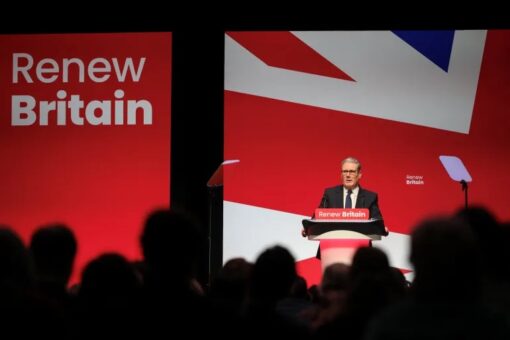In a dramatic political showdown, Starmer confronts Farage head-on at the Labour conference, delivering one of his most forceful attacks yet on the Reform UK leader. But the moment was overshadowed by Greater Manchester Mayor Andy Burnham’s sudden walkout, a move that signalled internal dissent within Labour even as Starmer sought to project unity.
The phrase “Starmer confronts Farage” summed up more than a speech; it defined the tension between Britain’s future directions — one rooted in Starmer’s appeal for decency and responsibility, the other in Farage’s brand of populist nationalism.
Yet it also highlighted the cracks within Labour itself, raising the question: can the party maintain cohesion as it faces external threats and internal fractures?
Starmer Confronts Farage: Drawing the Battle Lines
From the very start, Starmer confronts Farage not just by name, but by framing him as the embodiment of division. He accused the Reform UK leader of peddling false solutions, particularly on immigration, branding Farage’s proposals “racist and immoral.”

Starmer contrasted his vision of a fairer, inclusive Britain with what he called Farage’s “politics of grievance.” His rhetoric was clear: Britain must choose between “decency or division.” In that moment, the Labour leader’s strategy was evident — define Farage as an extremist, while presenting himself as the reasonable alternative capable of governing responsibly.
Burnham Walkout Protest: A Symbol of Party Division
Yet, just as Starmer confronts Farage from the stage, another drama unfolded in the hall. Andy Burnham left the room before the Prime Minister’s speech, an act widely interpreted as a symbolic protest against Starmer’s leadership style.
Burnham, long seen as a potential rival with his own populist edge, has often voiced frustration with the centralised control of Labour under Starmer. His walkout — quiet but calculated — highlighted the Labour party divisions that persist despite electoral gains. For many observers, the walkout underlined that the Labour leadership test extends beyond beating Reform UK: it is also about managing dissent within.
Farage Seizes the Narrative
Predictably, Farage wasted no time spinning the confrontation to his advantage. By presenting himself as a victim of Starmer’s “smear campaign,” he portrayed Labour as intolerant and dismissive of working-class voters. Reform UK doubled down, arguing that Starmer’s rhetoric was proof the establishment feared their growing momentum.

For Farage, the fact that Starmer confronts Farage so directly is itself a victory: it legitimises him as a central player in Britain’s political arena. Every mention of his name by the Prime Minister reinforces his relevance, something Reform UK will undoubtedly exploit.
Labour’s Struggles Beneath the Surface
Behind the applause for Starmer’s speech lay a deeper unease. While MPs and loyalists responded warmly to his attacks on Farage, grassroots delegates were less enthusiastic. Critics within Labour argue that the leadership is suppressing dissent and alienating regional voices — with Burnham’s protest the most visible symbol of this frustration.
Starmer attempted to balance confrontation with policy, announcing initiatives like an NHS “online hospital” to reduce waiting times and pledges on housing and accountability. Yet sceptics argue that words are no longer enough — real delivery is needed to maintain credibility.
For many, the key challenge is not only that Starmer confronts Farage publicly, but whether he can simultaneously unite his own ranks and deliver tangible results quickly enough to retain voter trust.
The Bigger Picture: Britain at a Crossroads
The Labour conference showdown encapsulated the crossroads Britain now faces. On one side, Starmer insists on unity, fairness, and responsibility; on the other, Farage promises bold, disruptive populism. But the drama also revealed a third tension: the divisions inside Labour itself.
If Labour can solidify behind its leader, Starmer may succeed in positioning Farage as an extremist threat rather than a viable alternative. But if Burnham and others continue to challenge the leadership, Labour risks appearing fractured — a vulnerability Farage will eagerly exploit.
Ultimately, the defining image of the conference was this: Starmer confronts Farage under the lights, while Burnham slips out the back. That duality — external conflict and internal fracture — may shape the next phase of British politics.
More news here


